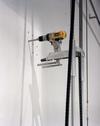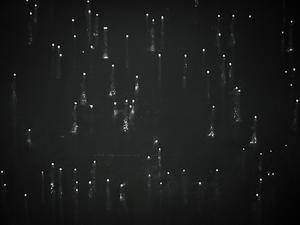
MURAL
WHITNEYMUSEUMOFAMERICANART,NEWYORK,NY
Scanning: The Aberrant Architectures of Diller + Scofidio was a retrospective exhibition that brought together diverse large-scale works on the fourth floor of the Whitney Museum of American Art. A retrospective—an invention of modern museums—assembles disparate projects into a single “body” of work in order to present a cohesive overview of an artist’s creative development. But the projects exhibited in Scanning were site-specific and had been conceived at different times and places, commissioned by various institutional clients. Consequently, they resisted the cohesion and homogenizing effect of a retrospective. The show thus served as the pretext for a new work about walls, galleries, and the neutrality of the white cube.
A network of partition walls was built to divide the open exhibition space into a sequence of galleries, one for each work. Rather than relegated to mere background, however, the walls were instead called into action as part of a new work, Mural. These walls had to be sabotaged. The protagonist was a standard DeWalt power drill held by a robotic arm controlled by a computer “brain” and guided along a track mounted on the partition walls. The robotic drill was designed in collaboration with engineers from Honeybee Robotics who were simultaneously developing drills for NASA’s Mars rover.
The drill cruises through the exhibition following a three-hundred-foot-long path that passes in and out of each gallery. An intelligent navigator controls the process: the computer system creates a map of the wall surfaces, then randomly generates points within a three-dimensional matrix and guides the robotic arm to a selected point. The drill would arrive, pierce the drywall, and travel to the next location, leaving behind a half-inch hole. The debris was collected in a canister attached to the drill. Curving tracks allowed the robot to turn corners.
The holes began as lone blemishes on the pristine walls. As the exhibition continued, the perforations grew in number. Eventually, holes on both sides of the wall aligned, opening views into adjacent galleries. Clusters of holes created large voids in the wall surface. The walls became increasingly unstable as the robotic drill’s three-month-long performance progressed. The drilling noise was a pervasive sonic backdrop that disturbed the isolation between galleries. It was an acoustic nuisance that actively competed for the attention of visitors.
The white color of the museum wall is taken for granted as a default, neutral surface. But was the white of the Whitney’s gallery walls the same as the walls in the Museum of Modern Art (MoMA)? Would it be possible to transplant a section of wall from one museum to another without anyone noticing the difference? The timing of the retrospective perfectly aligned with MoMA’s extensive renovation and reinstallation of its permanent collection, completed in 2004. The construction project provided an opportunity to acquire a desired wall fragment that would otherwise be demolished: the portion that had been hidden beneath Marcel Duchamp’s 1914 painting Network of Stoppages. The museum granted permission for a crew to remove the patch of wall, which was then grafted onto a wall at the Whitney. There, MoMA’s white wall—with its many layers of built-up paint—sat slightly protruding from the Whitney-white wall, noticeably brighter than the surrounding white surface. The robotic drill changed behavior upon entering the zone of the MoMA fragment, as if under the influence of Duchamp’s aura. A serial pattern started to emerge from the random one.
When the retrospective was dismounted, the wall graft was salvaged and subsequently cut into two-foot-by-two-foot scraps that were distributed to friends as souvenirs. Unexpectedly, MoMA acquired a spare fragment for its permanent collection. The piece was displayed in Rough Cut: Design Takes a Sharp Edge (2008), a group show curated by Paola Antonelli. The show’s installers removed a square of wall from the newly expanded MoMA gallery to make room for the scrap that had once lived beneath Marcel Duchamp’s painting—its former home. The wall’s round-trip journey was complete.
Decommissioned after the retrospective, the drill was revived for the inaugural exhibition of the MAXXI contemporary art museum in Rome, which opened in 2010. Rather than drill through the museum walls, the robot was reprogrammed as an engraving device. It bored into the MAXXI wall surface to different depths, creating circular pits of various sizes and producing the equivalent of a halftone image. The intelligent drill produced a seventy-foot-long mural depicting one of the greatest man-made environmental disasters in history: the BP oil spill in the Gulf of Mexico. The piece was renamed Drill Baby Drill.
Mural was created in collaboration with Honeybee Robotics for the retrospective exhibition curated by Aaron Betsky and K. Michael Hays, at the Whitney Museum of American Art. Drill Baby Drill was commissioned for SPAZIO, an inaugural exhibition at the MAXXI in Rome, curated by Pippo Ciorra, Alessandro D’Onofrio, Bartolomeo Pietromarchi, and Gabi Scardi.

 Installation drill detail
Installation drill detail
- Hole tests
| Location Whitney Museum of American Art , New York, United States |
| Opened1st March 2003 | closed25th May 2003 |
| Team | Elizabeth Diller,Ricardo Scofidio,Matthew Johnson,Mark Wasiuta,and Don Shillingburg |
| Aaron Betsky | Curator |
| K. Michael Hays | Curator |


